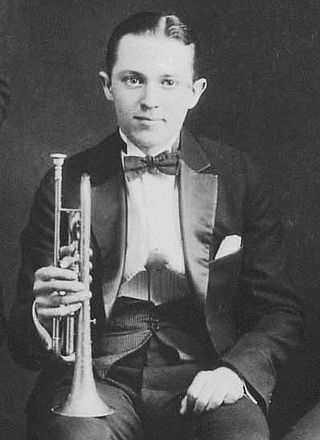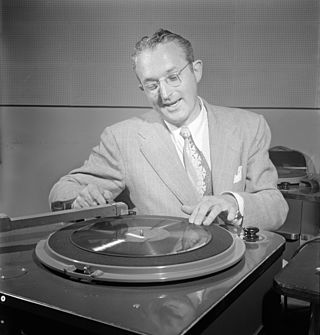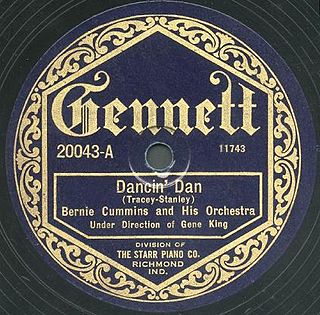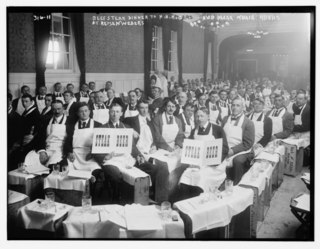Related Research Articles

Leon Bismark "Bix" Beiderbecke was an American jazz cornetist, pianist and composer.

The Original Dixieland Jass Band (ODJB) was a Dixieland jazz band that made the first jazz recordings in early 1917. Their "Livery Stable Blues" became the first jazz record ever issued. The group composed and recorded many jazz standards, the most famous being "Tiger Rag". In late 1917, the spelling of the band's name was changed to Original Dixieland Jazz Band.

Thomas Francis Dorsey Jr. was an American jazz trombonist, composer, conductor and bandleader of the big band era. He was known as the "Sentimental Gentleman of Swing" because of his smooth-toned trombone playing. His theme song was "I'm Getting Sentimental Over You". His technical skill on the trombone gave him renown among other musicians. He was the younger brother of bandleader Jimmy Dorsey. After Dorsey broke with his brother in the mid-1930s, he led an extremely successful band from the late 1930s into the 1950s. He is best remembered for standards such as "Opus One", "Song of India", "Marie", "On Treasure Island", and his biggest hit single, "I'll Never Smile Again".

Hoagland Howard Carmichael was an American musician, composer, songwriter, actor and lawyer. Carmichael was one of the most successful Tin Pan Alley songwriters of the 1930s, and was among the first singer-songwriters in the age of mass media to utilize new communication technologies such as television, microphones, and sound recordings.
RCA Records is an American record label owned by Sony Music Entertainment, a subsidiary of Sony Corporation of America.

Gennett Records was an American record company and label in Richmond, Indiana, United States, which flourished in the 1920s and produced the Gennett, Starr, Champion, Superior, and Van Speaking labels. The company also produced some Supertone, Silvertone, and Challenge records under contract. The firm also pressed, under contract, records for record labels such as Autograph, Rainbow, Hitch, Our Song, and Vaughn; Gennett also pressed records for the Ku Klux Klan (KKK). Gennett produced some of the earliest recordings by Louis Armstrong, King Oliver, Bix Beiderbecke, and Hoagy Carmichael. Its roster also included Jelly Roll Morton, Blind Lemon Jefferson, Charley Patton, and Gene Autry.

"Stardust" is a 1927 song composed by Hoagy Carmichael, with lyrics later added by Mitchell Parish. It has been recorded as an instrumental or vocal track over 1,500 times. Carmichael developed a taste for jazz while attending Indiana University. He formed his own band and played at local events in Indiana and Ohio. Following his graduation, Carmichael moved to Florida to work for a law firm. He left the law sector and returned to Indiana, after learning of the success of one of his compositions. In 1927, after leaving a local university hangout, Carmichael started to whistle a tune that he later developed further. When composing the song, he was inspired by the end of one of his love affairs, and on the suggestion of a university classmate, he decided on its title. The same year, Carmichael recorded an instrumental version of the song for Gennett Records.
Jazz standards are musical compositions that are an important part of the musical repertoire of jazz musicians, in that they are widely known, performed, and recorded by jazz musicians, and widely known by listeners. There is no definitive list of jazz standards, and the list of songs deemed to be standards changes over time. Songs included in major fake book publications and jazz reference works offer a rough guide to which songs are considered standards.

"Georgia on My Mind" is a 1930 song written by Hoagy Carmichael and Stuart Gorrell and first recorded that same year by Hoagy Carmichael at the RCA Victor Studios at 155 East 24th Street in New York City. However, the song has been most often associated with soul singer Ray Charles, who was a native of the U.S. state of Georgia and recorded it for his 1960 album The Genius Hits the Road.

Walter Louis Garland, known professionally as Hank Garland, was an American guitarist and songwriter. He started as a country musician, played rock and roll as it became popular in the 1950s, and released a jazz album in 1960. His career was cut short when a car accident in 1961 left him unable to perform.

Robert Sage Wilber was an American jazz clarinetist, saxophonist, and band leader. Although his scope covers a wide range of jazz, Wilber was a dedicated advocate of classic styles, working throughout his career to present traditional jazz pieces in a contemporary manner. He played with many distinguished jazz leaders in the 1950s and 1960s, including Bobby Hackett, Benny Goodman, Sidney Bechet, Jack Teagarden and Eddie Condon. In the late 1960s, he was an original member of the World's Greatest Jazz Band, and in the early 70s of Soprano Summit, a band which gained wide attention. In the late 1970s, he formed the Bechet Legacy Band.
Donald Alton Fagerquist was a small group, big band, and studio jazz trumpet player from the West Coast of the United States.

"Washboard Blues" is a popular jazz song written by Hoagy Carmichael, Fred B. Callahan and Irving Mills. It was first recorded for Gennett Records in May, 1925 by Hitch's Happy Harmonists with Carmichael on piano. It was subsequently recorded by jazz bands Original Memphis Five (1925) and Red Nichols and his Five Pennies (1926).

Harry Allen is an American jazz tenor saxophonist born in Washington, D.C. Allen plays maintream jazz and bossa nova. He has performed live and recorded with Scott Hamilton, a tenor saxophonist to whom Allen has frequently been compared. He is best known for his work with John Colianni, Dori Caymmi, Keith Ingham, John Pizzarelli, and Bucky Pizzarelli.
Joe Mondragon was an American jazz bassist.
"Rockin' Chair is a 1929 popular song with lyrics and music composed by Hoagy Carmichael. Musically it is unconventional, as after the B section when most popular songs return to A, this song has an A-B-C-A1 structure. Carmichael recorded the song in 1929, 1930, and 1956. Mildred Bailey made it famous by using it as her theme song. Like other 1920s standards, "Rockin' Chair" relied on the stereotypes of minstrelsy, citing "Aunt Harriet" from the anti-Uncle Tom song "Aunt Harriet Becha Stowe" (1853).

Frankie and Johnny is the twelfth soundtrack album by American singer and musician Elvis Presley, released on RCA Victor Records in mono and stereo, LPM/LSP 3553, in April 1966. An excursion into Dixieland and ragtime music, it is the soundtrack to the 1966 film of the same name starring Presley. Recording sessions took place at Radio Recorders in Hollywood, California, on May 12, 13, and 14, 1965. It peaked at number 20 on the Top LP's chart. It was certified Gold and Platinum on January 6, 2004, by the Recording Industry Association of America.
A & R Recording Inc. was a major American independent studio recording company founded in 1958 by Jack Arnold and Phil Ramone.

Clarinet Marmalade, later Clarinet Marmalade Blues, is a 1918 dixieland jazz standard composed by Larry Shields and Henry Ragas of the Original Dixieland Jass Band. It is played in the key of F major. It was recorded by Fletcher Henderson in 1926 and Frankie Trumbauer in 1927.

Reisenweber's Cafe, also known as Reisenweber's Restaurant or simply Reisenweber's, was a restaurant, nightclub, and hotel in Columbus Circle, Manhattan, on the intersection of Eighth Ave and 58th Street, from 1856/7 to 1922.
References
- ↑ Andrews, Travis M. (March 20, 2019). "Jay-Z, a speech by Sen. Robert F. Kennedy and 'Schoolhouse Rock!' among recordings deemed classics by Library of Congress". The Washington Post. Retrieved March 25, 2019.
- ↑ Schoenherr, Steven. "Recording Technology History". History.sandiego.edu. Archived from the original on March 12, 2010. Retrieved 2008-12-24.
- ↑ Thomas, Bob (1994). "The Origins of Big Band Music". redhotjazz.com. Archived from the original on December 28, 2008. Retrieved 2008-12-24.
- ↑ Alexander, Scott. "The First Jazz Records". redhotjazz.com. Archived from the original on 2008-12-28. Retrieved December 24, 2008.
- ↑ "Jazz Milestones". apassion4jazz.net. Retrieved 2008-12-24.
- ↑ "Original Dixieland Jazz Band Biography". pbs.org. Retrieved 2008-12-24.
- ↑ Martin, Henry; Waters, Keith (2005). Jazz: The First 100 Years. Thomson Wadsworth. p. 55. ISBN 0-534-62804-4.
- 1 2 Zirpolo, Mike (9 September 2018). "Victor's 24th Street New York Recording Studio/"Cherokee" (1939) Charlie Barnet". Swing & Beyond. Retrieved 14 December 2023.
- 1 2 Schmidt Horning, Susan (2013). Chasing Sound: Technology, Culture & the Art of Studio Recording from Edison to the LP. Baltimore, United States: Johns Hopkins University Press. pp. 82–86. ISBN 978-1-4214-1848-3.
- ↑ Ferrara, Samantha (30 July 2020). "How The Victor Company & A Camden County NJ Native Helped Build Carol King's Recording Career". victorrecords.com. Victor Musical Industries Inc. Retrieved 14 December 2023.
- ↑ Gioia, Ted (2012). The Jazz Standards: A Guide to the Repertoire. New York City: Oxford University Press. pp. 122–124. ISBN 978-0-19-993739-4.
- ↑ Carmichael, Hoagy; Longstreet, Stephen (1976). Sometimes I Wonder: The Story of Hoagy Carmichael (Repr. d. Ausg. New York 1965. ed.). New York: Da Capo. ISBN 9780306708091.
- ↑ Spragg, Dennis M. (November 2019). "How 'Moonlight Serenade' Defined a Generation". Smithsonian Magazine. Retrieved 20 December 2023.
- ↑ Spragg, Dennis M. "Glenn Miller: April 28, 1940". dennismspragg.com. Dennis M. Spragg. Retrieved 20 December 2023.
- ↑ "The Brakeman Auditions for Ralph Peer - A Milestone In Country Music" (PDF). Billboard. 2 November 1963. Retrieved 15 December 2023.
- ↑ "Letters: Audio Society Activities" (PDF). aes.org. Audio Engineering Society. Retrieved 20 December 2023.
- 1 2 3 "Remembering Elvis on East 24th Street". flatironnomad.nyc. Flatiron Nomad. 12 August 2019. Retrieved 16 August 2022.
- 1 2 "Elvis Presley - The New York Sessions 1956". Elvispresleymusic.com.au. Retrieved 20 December 2023.
- 1 2 "Before the Vertical Campus: RCA Recording Studio". Baruch Campus Evolution. City University of New York . Retrieved 22 December 2023.
- 1 2 Volkmann, J.E.; Stevens, A. (December 1971). "New York recording studios" (PDF). RCA Engineer. RCA. Retrieved 15 December 2023.
- ↑ Foti, Laura (6 February 1982). "RCA Studio 'Holding Its Own' As Budgets Tighten". Billboard. Retrieved 7 May 2024.
- ↑ Daley, Dan (October 2014). "Off The Record: Music & Recording Industry News". Sound On Sound. SOS Publications Group. Retrieved 16 August 2022.
- ↑ Schmidt Horning, Susan (2013). Chasing Sound: Technology, Culture & the Art of Studio Recording from Edison to the LP. Baltimore, United States: Johns Hopkins University Press. p. 86. ISBN 978-1-4214-1848-3.